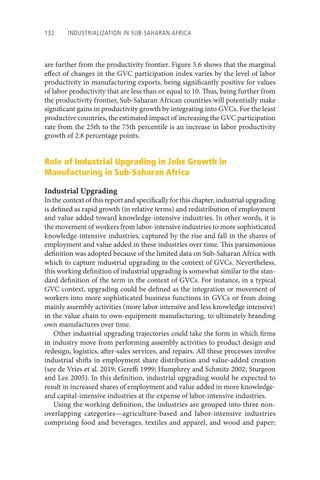132 Industrialization in Sub-Saharan Africa
are further from the productivity frontier. Figure 5.6 shows that the marginal effect of changes in the GVC participation index varies by the level of labor productivity in manufacturing exports, being significantly positive for values of labor productivity that are less than or equal to 10. Thus, being further from the productivity frontier, Sub-Saharan African countries will potentially make significant gains in productivity growth by integrating into GVCs. For the least productive countries, the estimated impact of increasing the GVC participation rate from the 25th to the 75th percentile is an increase in labor productivity growth of 2.8 percentage points.
Role of Industrial Upgrading in Jobs Growth in Manufacturing in Sub-Saharan Africa Industrial Upgrading
In the context of this report and specifically for this chapter, industrial upgrading is defined as rapid growth (in relative terms) and redistribution of employment and value added toward knowledge-intensive industries. In other words, it is the movement of workers from labor-intensive industries to more sophisticated knowledge-intensive industries, captured by the rise and fall in the shares of employment and value added in these industries over time. This parsimonious definition was adopted because of the limited data on Sub-Saharan Africa with which to capture industrial upgrading in the context of GVCs. Nevertheless, this working definition of industrial upgrading is somewhat similar to the standard definition of the term in the context of GVCs. For instance, in a typical GVC context, upgrading could be defined as the integration or movement of workers into more sophisticated business functions in GVCs or from doing mainly assembly activities (more labor intensive and less knowledge intensive) in the value chain to own-equipment manufacturing, to ultimately branding own manufactures over time. Other industrial upgrading trajectories could take the form in which firms in industry move from performing assembly activities to product design and redesign, logistics, after-sales services, and repairs. All these processes involve industrial shifts in employment share distribution and value-added creation (see de Vries et al. 2019; Gereffi 1999; Humphrey and Schmitz 2002; Sturgeon and Lee 2005). In this definition, industrial upgrading would be expected to result in increased shares of employment and value added in more knowledgeand capital-intensive industries at the expense of labor-intensive industries. Using the working definition, the industries are grouped into three nonoverlapping categories—agriculture-based and labor-intensive industries comprising food and beverages, textiles and apparel, and wood and paper;

